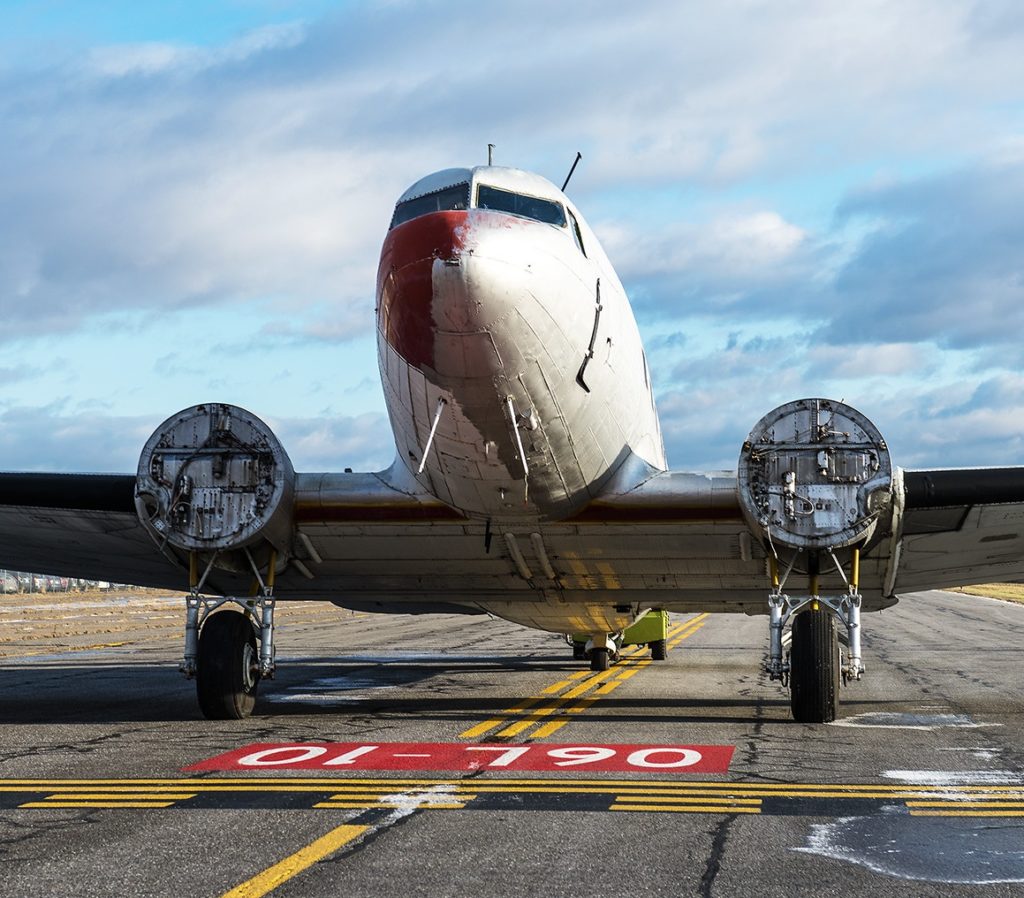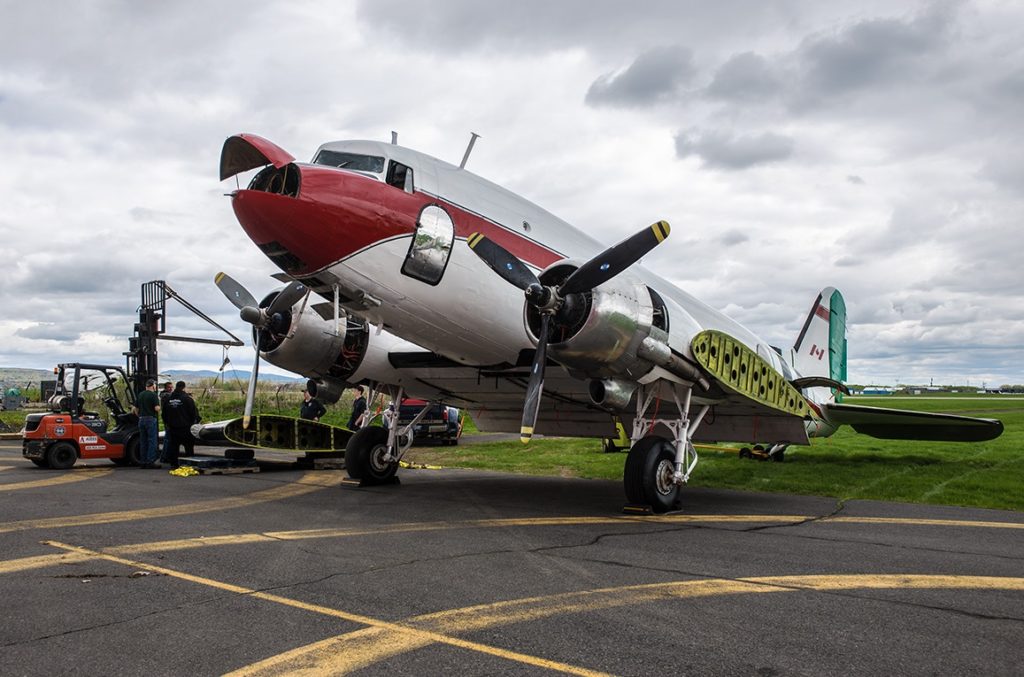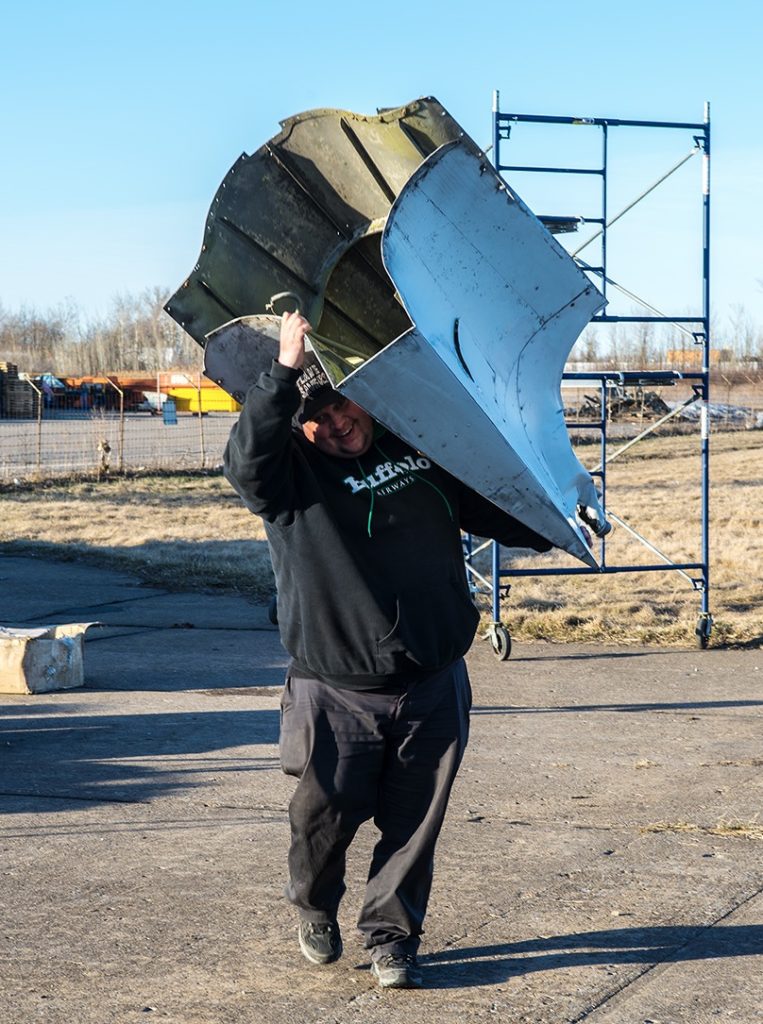Estimated reading time 12 minutes, 30 seconds.
Seventy-five years after it dropped 17 paratroopers behind German lines in Normandy on D-Day, more than 500 aviation fans gathered at Montreal Saint-Hubert Longueuil Airport — and more than 5,850 watched online — as the Douglas DC-3, C-FDTD, made its first flight in almost 30 years on June 6 to commemorate its important role helping to defeat the Nazis in Europe.

The flight lasted about 30 minutes as pilots “Buffalo Joe” McBryan and Quinn Jones made several circuits of Saint-Hubert Airport in the bright evening sun.
For the past 73 years, this D-Day veteran has been hiding in plain sight at Canadian airports, but its historical significance only became widely known late last year after it was purchased by Mikey McBryan, general manager of Buffalo Airways after being advertised for sale on eBay.
Mikey purchased the aircraft and decided to restore it to flying condition by the D-Day anniversary using a small team from Buffalo Airways, friends and local volunteers.
From a historical perspective, Plane Savers have literally saved Quebec’s last Douglas DC-3 from an uncertain fate.
From a social media perspective, Plane Savers became the most popular aviation show in Canada in early 2019 as Mikey recorded every step of the restoration process. He uploaded the first of 159 video episodes of Plane Savers (including a prologue and a two-part episode) to his YouTube channel on Dec. 29, 2018.
All totalled, Mikey produced more than 50 hours of interesting and amusing video content, which had been viewed over 3 million times (by June 6) or an average of 25,000 times per episode.
Of course, Mikey and family are no strangers to the TV screen, thanks to their leading role in the reality television series Ice Pilots NWT which profiled life at Buffalo Airways on History Television over six seasons between 2009 and 2014.
Operation Overlord
Nearly 150,000 Allied troops landed or parachuted into Normandy on June 6, 1944, and 14,000 were Canadians.

The airborne assault included more than 800 Douglas C-47 Dakotas towing gliders and dropping paratroopers behind German lines, including the aircraft that would later become C-FDTD.
Built by Douglas Aircraft in January 1944 at its plant in Oklahoma City, aircraft serial number 12253 was flown to the Royal Air Force (RAF) station at Dorval, Que., on Feb. 4, 1944, assigned the RAF serial FZ668 and ferried across the Atlantic to the United Kingdom. There it was assigned to 271 Squadron based at RAF Blakehill Farm near Cricklade in Wiltshire, England.
On June 5, Dakota FZ668 took off at 11:20 p.m. as one of a fleet of 108 RAF C-47s whose mission was to neutralize the German forces behind the beaches to be used for the landings. Seventeen paratroopers jumped at around 12:50 a.m. on DZ (drop zone) “K” located near Toufreville. Five of these soldiers were killed and three more were captured by the Germans within four days.
Following the invasion, Dakota FZ668 flew regularly to France with urgently needed freight, ammunition and food and repatriated wounded soldiers to the United Kingdom on the return flights.
On Sept. 18, 1944, it participated in Operation Market Garden and towed an RAF Horsa assault glider loaded with troops, a jeep and a six-inch cannon as part of an Allied assault to secure bridgeheads on the Rhine at Arnhem. The German Army mounted a fierce counter attack and Dakota FZ668 helped resupply the Allied troops and the crew managed to survive the powerful anti-aircraft defences that shot down many other crews.
Civilian service
Many of the 10,000 C-47s Douglas produced remained in military service after the war, while others were converted into civilian DC-3s for airline use.
Canadair of Montreal bought Douglas C-47A serial 12253 after its retirement from the RAF and it was ferried to Montreal’s Cartierville Airport where more than 250 C-47s were refurbished for civilian use including 30 delivered to Trans-Canada Airlines between 1945 and 1947.
The DC-3 entered TCA service on April 4, 1947, as CF-TER and served communities in Canada and the U.S. for a decade until withdrawn from service around the summer 1957. It was then transferred to the Department of Transport and re-registered CF-DTD. Transport Canada retired the aircraft at Ottawa Airport in the late 1980s.
Then in the early 1990s it was acquired by the Fondation Aérovision Québec and trucked to Saint-Hubert Airport, but plans to establish a local aviation museum faltered and the aircraft was vandalized while stored.
In April 2017, aviation enthusiast Benoit de Mulder acquired it and transferred it to Avialogs Aéronautique in early 2018, but he was unable raise the financing to restore her in a timely manner, so he listed the aircraft for sale on eBay in October 2018 along with its D-Day story.
DC-3s were once commonplace in Canada, but Buffalo Airways is the last commercial operator and the Canadian Warplane Heritage Museum the only museum operator of a “round engine” DC-3 since the Basler BT-67 turbine conversion became popular.
New project?
“I heard about the aircraft as soon as it was listed for sale on eBay,” said Mikey. “Lots of people who know me from Ice Pilots and social media started sending me links to the aircraft listing.”

Buffalo had just sold several of its inactive DC-3s to Basler Turbo Conversions in Oshkosh, Wis., for conversion to P&WC PT6 turbine power, but the idea of restoring the DC-3 to fly on the 75th anniversary of D-Day was very appealing, Mikey told Skies.
However, before he bought the aircraft he had to receive positive commitments of support from his father Joe, his brother Rod, his uncle Ron (Ronny) and his friend Jay Caldwell.
When all four confirmed their support to the restoration, Mikey bought “DTD” and Plane Savers was born.
Mikey made his first trip to Saint-Hubert to inspect the aircraft in early January with his partner Stella Heidorn and his uncle Ronny. That’s where they drafted a long list of missing or damaged parts they needed to obtain from the Buffalo’s idle DC-3 fleet in Red Deer, Alta., which included two former Transport Canada DC-3s retired at the same time as C-FDTD.
During January and February, two spare Pratt & Whitney R-1830 Twin Wasps were made serviceable and all the parts required for the restoration, plus shop tools loaded into a 40-foot shipping container for delivery to Saint-Hubert by truck in early April.
“Everything was a major challenge,” said Mikey. “Take your pick. We had no data tag for the aircraft, no certificate of airworthiness, lots of missing parts, no access to the aircraft and snow.”
“The whole project grew organically right on the screen,” recalled Mikey. “It was like [the film] Field of Dreams…’If you build it, they will come.'”
Fortunately, Ronny McBryan has lots of experience bringing 16 piston engine airliners back to life, including six Douglas C-54s (DC-4s) ferried one at a time from Chico, Calif., to Hay River, N.W.T., using a single set of four Pratt & Whitney R-2000 radial engines that he transferred from one aircraft to another.
In addition to installing new engines and propellers, the Plane Savers team had to make structural repairs to a rudder mount and wing tip, inspect the fuel system and control cables, and installed replacement avionics, instruments and circuit breakers without access to the aircraft’s postwar wiring diagram.
In the final weeks, D-Day invasion strips were applied to the tail of the aircraft, used to distinguish friend and foe over Normandy, as well as a large Royal Air Force roundel.
Mikey did a lot of work behind the scenes scheduling volunteers and work on the aircraft, ordering parts in addition to spending three to four hours every day shooting and editing video.
Mikey had a lot of experience using his GoPro 7 and iPhone 7+ to take photos for his Instagram account, “but I never knew how to edit video” using Final Cut Pro with his MacBook Air until he committed to posting a video-a-day.
He shot videos throughout each day which were edited chronologically and posted to YouTube around 6:30 p.m. after adding the last clip of the day.

Many of the volunteers achieved minor celebrity status when followers of the show recognized them walking in downtown Montreal and elsewhere.
ENA Provides Huge Support
Early in the project, avionics, sheetmetal and power plant instructors from École Nationale d’Aérotechnique (ÉNA) stepped forward to provide invaluable support to the restoration project. ENA has the largest equipped aircraft maintenance technology school in Canada and the best equipped workshops and labs. These were used to trouble shoot and test the aircraft avionics and make essential brackets and parts.
The project quickly attracted ENA student volunteers who worked on DTD around classes and final exams and ENA also generously made two hangars available to accommodate the aircraft so work could rapidly advance during very wet spring weather.
In the end, the contribution made by ENA was essential to complete the restoration on time and they also provide Mikey McBryan with an on-site studio space for his daily YouTube video broadcast.
Future
Mikey personally owns DTD and plans to take it to EAA AirVenture in Oshkosh in July to personally thank everyone who supported the restoration.
Future plans for the aircraft have not been finalized but retelling its’ D-Day story is certainly in the plans.









Nice article. However, you totally missed the critical and indispensible role played by ÉCOLE NATIONALE D’AÉROTECHNIQUE (ÉNA) located at the Saint-Hubert airport. Without the love and dedication of the program instructors and student volunteers, not to mention the facilities and hangar time given to the Plane Savers crew, I would guess this plane would not be close to flying yet.
Give them a mention – they were top notch!
Awesome achievement!!!! Am going to have Plane Savers withdrawal. Followed every episode from day one. Big Buffalo Airways fan from the get go.
This shows people with caractor and courage, congratulation.
Much like the wartime fervor of the home front in supplying the necessary materials, so was the effort of the ENA and it’s people as well as the thousands of fans who contributed not only moral but monetary support to the project. It was a desire to succeed that every one shared. World War Two was won by every one working together to achieve the same goal, so was this project with the help of many many sources and people. Mikey was the Eisenhower of the project and his aide de camp Stella was also a big part as well. All the teachers and students of ENA can be very proud of their contribution and I am sure they found a new love of the radial engine.